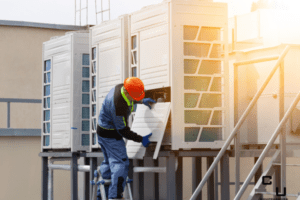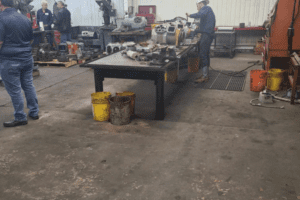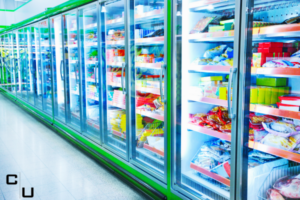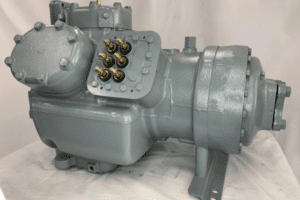

A substantial part of energy loss in grocery stores is through refrigerated cases and walk-in coolers. As the energy used in this equipment is rejected to the outside, it makes the refrigeration compressors in each unit work harder. This raises energy bills and reduces the lifespan of compressor units.
All displayed goods throughout a grocery store rely on compressor units to maintain their temperature. In general, a smaller display is more energy-efficient than a larger one, and a display where casing can be closed to create a tight seal is more efficient than one open to the air.
Optimizing Refrigeration Systems in Your Grocery Store
All in all, commercial refrigeration for grocery stores consumes about half the energy used by such a store. Within each refrigerated environment, the commercial compressor, like a Copeland 6RA2000TSK, is the single largest energy consumer. There are two main variables that help determine the compressor efficiency:
1. Lift
Lift is the temperature differential across the compressor unit. This is derived from the difference in temperature between the evaporator, which serves as the heat source, and the condenser, acting as the unit’s heat sink.
2. Mass Flow of Refrigerant
The mass flow of refrigerant is the main factor in the unit’s refrigeration capacity. Today’s most efficient compressors are those that enable system-wide adjustments in response to reduced load, particularly adjustment of the evaporator temperature.
To meet the challenges of today’s large, energy-intensive refrigeration environments, many grocery stores are finding new ways to improve system performance. One technique is to integrate the HVAC and refrigeration systems so reclaimed heat rejected by refrigeration units can be reused.
Heat recovered from the refrigeration system can be redirected to meet a variety of low-level heating needs throughout the rest of the store. To avoid having a negative effect on overall refrigeration, this heat should be at the lowest possible useful temperature.
Before heat recovery systems can be implemented, it’s crucial to get a better sense of your heating needs. Stores with many open case displays can be very demanding of heat. A high balance point, the exterior temperature at which heating is required, means other efficiency measures are often needed before heat recovery will be worthwhile.
Retrofitting open displays to include glass doors will make a significant impact on the energy use of each refitted case. Individual compressor units will also use less energy and maintain the desired temperature for a longer period of time.
Maintaining High Performance for Your Grocery Store Compressor Units
Many grocery stores have enhanced compressor performance by switching to parallel compressor refrigeration racks. These are used in many newer U.S. grocery stores, popular for their high energy efficiency and extremely accurate control. They are also easier to install than split systems.
These refrigeration racks utilize several skid-mounted compressors that cycle on and off as the total system load increases. The system architecture means it is never necessary to cycle a single large compressor that creates high electrical current inrush when it comes online.
That’s far superior to a split system, which is only ever “on” or “off” at any given moment.
Parallel racks are designed to match the refrigeration load all the way from about 25% of full design load to 100%. Air-cooled parallel racks can also be enhanced with a sophisticated internal controller that will float condensing temperature down when the ambient temperature drops.
Parallel refrigeration racks eliminate the fundamental problem of having a single point of fault. If one of the compressors goes offline, the rest of the array will still be able to operate at reduced capacity. This may be the key to protecting weeks’ worth of inventory in the event of a sudden failure.
That said, compressors within a parallel rack system are not intended to compensate indefinitely for a failed unit. Proactive maintenance is crucial for peak efficiency. These compressors may have a longer operational life, but they can still experience problems as they age.
When a compressor reaches eight years in service, it is time to step up maintenance and plan for its eventual replacement. While this usually happens around year ten, a system where compressors work in parallel may sometimes see units operate for 12 years or more.
Document your compressors’ make and model and be alert to changes in performance within individual racks so new compressors can be sourced in time. Since grocery stores may use dozens of compressors, a standing relationship with a compressor remanufacturer will help you keep a full fleet of compressors in the field while substantially reducing turnaround time and upfront investment.












